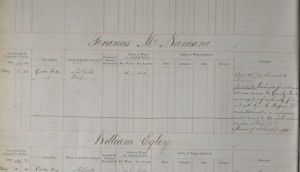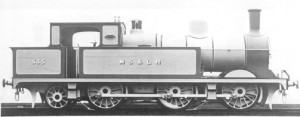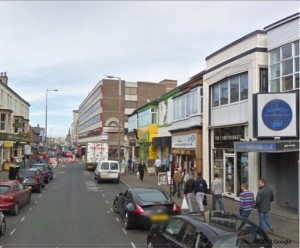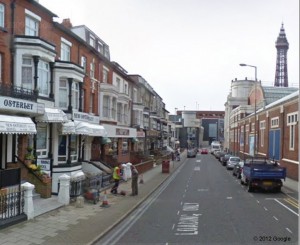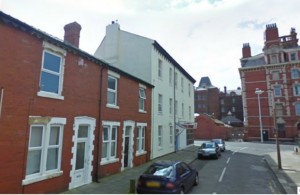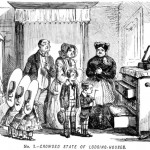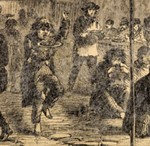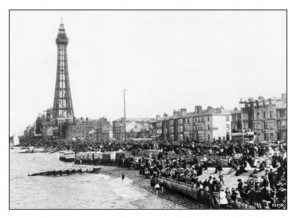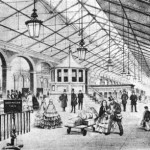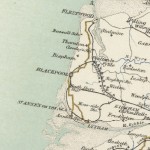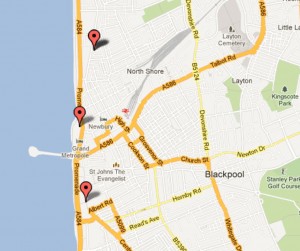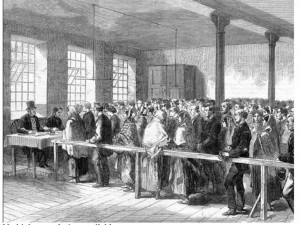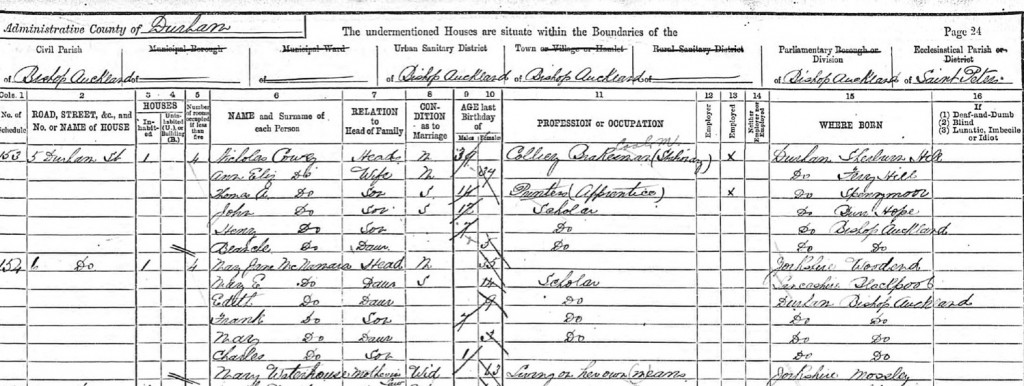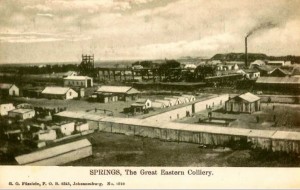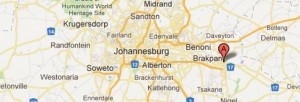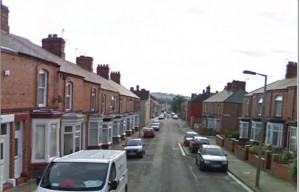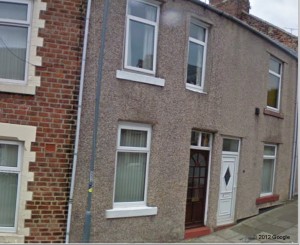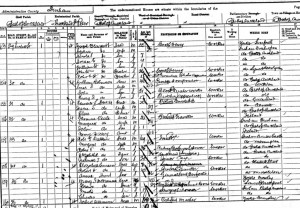McNamaras Established
THE FAMILY IN LANCASHIRE
It is information recorded on the 1851 Census which firmly establishes the McNamaras in Lancashire. The son of Bridget and William McNamara, our forebear, was listed as Francis McNamare (a transcription error) married to Elizabeth, the handwriting on the census sheet is nearly undecipherable and they were living at Brinnington, Lancashire, see here, which is some two miles NE of Stockport and now situated close to the the M60. They had not yet started a family and I cannot read the title of their occupations.
The 1851 census entry for Frances illustrates how difficult it can be to decipher census information.
Despite various searches I cannot find any trace of Francis on the 1861 Census. (It was not unusual for families to be missing from an early census. For instance if the census clerk delivering the forms could not find the house or did not bother to visit or even did not know the dwelling existed then there would be no record.)
There is, however, another record for Francis during the 1860s. His name is included on the Railway Employment Records 1833 – 1963, see the extract, below.
This is very difficult to read but it is clear that he was employed at Sheffield by the the Manchester, Sheffield and Lincolnshire Railway, see here.
His began his service on 8 May 1858 and worked as a goods porter. His salary was 18 shillings per week which is about £66 in terms of the RPI in 2013. Unfortunately he did not remain on the railways for long. On June 26 1861 he lost his job. It is difficult to unpick the report but it does include: ‘Discharged for insubordination … He was removed to Grimsby … in consequence of continually falling out with … conducting himself in an outrageous … coming to Manchester without …’ Thus a stain on the McNamara name to be continued by his son, see below.
By 1871 Francis and his wife were living at 15 Topping Street, Blackpool, with their children Francis William, 16, and Mary Hannah, 12. The home had five or less rooms. Francis was listed as a lodging house keeper and his wife, Elizabeth, as ‘wife of lodging house keeper’, presumably that indicated that she was involved with the work. The son was listed as a painter. There was an eldest child, Sarah Ellen, born in 1853 who was not living at the family home at the time of the census. I cannot establish where she was living at the time of the census. She was born at Stockport , although one census record has her as being born at Sheffield (which, if correct, would confirm the move from Lancashire to Sheffield some twenty years previously). Also living in the house was John Whalley, aged 66, a retired farmer. Frequently during the late Victorian and early c20th era there were one or more additional people found to be living in household, despite the limited space available.
Despite all the family protestations against the notion, I do suspect that Dad’s McNamara side of the family were descended from Catholic rather than Protestant Irish families since with Sarah and Mary they continued using traditional Catholic names. The picture below shows Topping Street as it is today, a not particularly attractive road in Blackpool not far from the sea. The McNamaras probably lived close to the lamp post on the right hand side of the road.
By 1881 the family had moved to 5 Adelaide Terrace, Blackpool (but written as Adelede on the census form) which cannot be traced on modern street maps. But there is an Adelaide Street, see below, which has been redeveloped in part but which is evidently Victorian in origin with large substantial terrace houses on the left hand side. The McNamaras probably lived in this road. This is a reasonable assumption since one would surmise that the house move sometime in the previous ten years would have been to a property superior to their previous home.
Residing in the home were Francis, now described as a valuer and house agent, his wife now classified as a lodging house keeper, their eldest daughter Sarah, 28, who has returned home and the younger daughter, Mary. Both are described as ‘assistant in house (inn servant)’, this probably meant that they had part time jobs as servants. Presumably, their son, Francis, had left home upon his marriage in 1875, see below. Also included in the household was a sister-in-law, Ellen Wood, 45, who was listed as a cripple and not working. This entry, fortunately, gives the lead to Elizabeth’s maiden name, namely Wood. As can be seen from the picture the road today is in sight of Blackpool Tower, although the Tower was not constructed until 1893.
By 1891 the family had moved again and were living at 5 Imperial Terrace, Blackpool. There is no Imperial Terrace in Blackpool today but there is an Imperial Street, see below. If we assume that this is where the family were living then it is probably a more modest home then their previous property. There were less than five rooms in the house. Francis was then recorded as a lodging house keeper and no occupation was recorded for his wife and daughter, Sarah, who was still living with them. Also living with them was Florie (full name Florence) McNamara, aged 11, who was their granddaughter and daughter of their married son, Francis, whose family were by then living at Bishop Aukland. This is a fortuitous record because this clearly establishes the link between the Lancashire McNamaras and County Durham McNamaras. The next two generations of McNamaras lived at Bishop Aukland or and County Durham Durham. Also living in the property was the family of George Cllier, a merchant, and his wife and three children aged 18, 16 and 12.
Finally, in later years the family moved yet again. In 1901 Francis and Elizabeth, aged 75, had moved some eight miles from Blackpool to an address on South Drive, St Annes on Sea (now included with Lytham St Annes). St Annes had developed as a sea side resort in the 1870s, see here. Their house was probably near the sea front at a location which had been redeveloped. One presumes that they had gone up in the world and become more prosperous since St Annes was and is one of the more select Lancashire towns favored by the retired. But the couple were still recorded as lodging house keepers. Their daughter, Sarah now aged 48, was still living with her parents. Also residing in the house were two females, one aged 40 and the other, 70, both were living on independent means.
And also staying with the family was another of their granddaughters, a daughter of their son, Francis, namely Mary (but listed as May on the census form, presumably a short form). She was born at Bishop Aukland in 1878. Her elder sister, Florence, who had been living with the Blackpool family ten years previously was born at Blackpool. The birth dates and places of Florence and Mary suggest that the son, Francis, and his wife are most likely to have moved from Lancashire to County Durham between 1876 and 1878. An extract from the census which establishes the link is provided below.
Both Francis and his wife died at St Annes on Sea in 1903.
Francis’s Wife
Francis’s wife was Elizabeth Wood who was born in 1826 and who died at St Annes on Sea in 1903. He married her in 1850 at Stockport. Elizabeth was the ninth of ten siblings. Elizabeth’s ancestry can be traced further back than her husband’s. Her parents were Samuel Wood, who was born about 1800 at Worth, Cheshire (see PDF Worth and Norbury) and who died at Stockport in 1864 and Ann Bennett who was born in 1805 at Norbury, Cheshire (seePDF Worth and Norbury) and who died in 1891 at Stockport. Samuel was one of eight children. Samuel’s parents were George Wood, again one of eight children, born about 1769 and who died in 1839 at Worth. He married Hannah in 1794 in Cheshire, nothing more is known about her. (Often the information on the female side runs out before that on the male side because one cannot trace the maiden name.) George Wood’s father was another George Wood, born in 1738 at Cheshire and who died in 1799 at Worth. In 1758 he married Betty, there is no further information available about her.
Lodging House Keeper
During his working life Francis was variously described as a valuer, house agent and lodging house keeper. One should not read current meanings onto these job descriptions. For instance in the Victorian era a valuer was simply a person who valued objects and a lodging house keeper was someone in charge of a lodging house – not necessarily the owner. Broadly speaking in Victorian times there were at least two types of lodging house keeper.
One was a person who was in charge of a large lodging house which provided accommodation for the poor or the growing numbers of mobile workers looking for work during the Industrial Revolution. For a history of the C19th lodging house see here.
- The Victorian lodging house
- A very different image of the lodging house
It is less likely that Francis was that type of lodging house keeper. He was more likely to have been providing accommodation for holiday makers.
In the Victorian era seaside holidays were becoming increasingly popular, see here for example, and during the latter part of the c19th Blackpool was developing as a major seaside resort. The opening of a railway line to Blackpool did much to encourage holiday activity and trade. Francis of course, knew all about railways.
- Victorian railway station
- Victorian railway connection to Blackpool
All three of the family homes in Blackpool were near the sea front, close to the promenade and pier and located within a mille of each other, see map below. And they lived in streets where lodging house keeper was the most common occupation among their neighbours.
A Comment on Francis’s Life
All we know of Francis and his life are some limited facts collected at ten yearly intervals, together with some reasonable inferences which can be drawn from the little we do know about him. It is interesting, however, to speculate further. He must have been a man of considerable energy and drive who demonstrated the Victorian values of hard work and striving for success. He probably never fully retired since he continued to be recorded with an occupation in the final years of his life.
We know from the census records that the family moved house at least once every decade. There must have been other moves unrecorded on census forms such as when he was sent to Grimsby after loosing his job at Sheffield. During his working life Frances clearly improved his job and prospects. He progressed from being a railway porter to lodging house keeper and eventually becoming a valuer and house agent. He and his wife spent the final years their life in the most up-market and superior holiday resort in the North West, namely St Annes on Sea.
Judging by the comments when he was dismissed as a railway porter in Sheffield he probably had a impudent and disrespectful side to his character. He will have been an audacious and forward thinking person; he was certainly not constrained by the limitations of his birth and home environment. It is very likely that he understood that the changing circumstances afforded by Victorian industrialisation and social change provided opportunities for him. Perhaps it was his work on the railways which encouraged him to realise that easier and faster travel and a more mobile population opened up opportunities for him and his family. Presumably he had the energy and outlook which enabled him to establish himself as a lodging house keeper in the North of England’s most rapidly developing seaside holiday destination, Blackpool.
He and his family must have always lived in what we would consider unexpectedly overcrowded conditions. Their modest homes were well built and indeed some still stand today. But they did not have many rooms bearing in mind the numbers of people living in the dwellings, including members of their extended family and lodgers. Even in their final years in St Annes they had lodgers in the house.
He must have been quite an impressive character.
A Skeleton in the Cupboard?
Continuing the McNamara story from the section above, the son of Francis and Elizabeth, Francis William McNamara, the great grandfather of David, Frank, Ian and Hugh was born at Stockport in 1855. He first appeared on the census record in 1861, aged six and was listed as a scholar. This is interesting because his parents cannot be located on this census (see above). He was living with his grandparents, Samuel and Ann Wood (see above) at 13 King St, Stockport. His younger sister, Mary Hannah, would have been two years old at that time, presumably she was in the care of her parents while Francis was living with his grandparents. Samuel, then aged sixty, was described as an engine tenter, that is a person who operated the machine which stretched the cloth whilst drying in a woolen mill. This may explain where Francis developed his interest in working with machinery.
What it does not explain is why Francis was not living with his parents in 1861. My speculative explanation is that the years from about 1858 to 1864 may well have been a time of upheaval and uncertainly in his parents’ life. The father obviously had an unsettled if not fractious time with his employers at the railway company (see above) and had moved jobs. The family could have faced upheaval and uncertainty at the time and been without a permanent home. Moreover, the economic outlook and job prospects were grim and Francis may have had to be mobile in order to find work. The depression known as the Lancashire Cotton Famine occurred between 1861 and 1865 see PDF Lancashire Cotton Riots and for an account see here.
This was caused by overproduction and fall in demand for cotton due to events associated with the American Civil War. The unsettled quality of Francis’s life could have meant that (a) his family had no settled home and was not recorded on a census of 1861 and (b) that the mother’s family, the Woods, had had to take responsibility for caring for young Francis.
By 1871 sixteen year old Francis William was back living with his parents at Stockport. He was described as a painter and he was the elder of two children.
In 1875 at the age of 20 Francis William married Mary Jane Waterhouse at Fylde and by the time of the 1881 Census the couple had moved from Lancashire to Bishop Aukland, County Durham and produced two children, Mary Elizabeth, aged four, and Florence, aged one. Because of the state of the cotton industry in lancashire it is understandable why the family moved from Stockport. But one can only surmise why the family moved to Bishop Auckland specifically. It was probably because during the 19th Century Industrial Revolution Bishop Aukland was a ‘boom town’ and a major centre for coal mining and iron works. In 1801 the population was 1,861 and by 1851 it was 5112, and ten years later it had doubled to over 10,000. For more information about the 19th Century development of Bishop Auckland, see here.
The move to County Durham most likely took place between 1876 and 1878 (see above for the explanation). Francis was by then a letter press operator, that is a printer using the letter press method. Four year old Mary was at school so we may assume that the family were literate and interested in the education of their children. Francis and Mary went on to have seven children. Frank, who became the grandfather of David, Frank, Ian and Hugh was their fifth child born in 1884. Francis William was not included on the next 1891 Census but Mary continued to live in County Durham, as is recorded on the census page below.
There is a family mystery about Francis William because there is no further mention of him on English records. And his death is not recorded in the UK. Our father, Henry, once mentioned to me something along the lines of ‘there had been a Francis McNamara who people though may have gone to South Africa’. it was left vague and speculative. There is, however, evidence to suggest that this was the case and that Francis did not behave with the probity expected from McNamaras. It must be accepted that while the evidence is available it has not been possible to independently verify it. The evidence indicates that sometime between 1889 and 1891 Francis emigrated to South Africa. A reasonable assumption is that in County Durham he had acquired some experience of the mining industry and that he went to South Africa to seek his fortune probably in the coal fields and less likely in the gold fields of the Transvaal – or maybe simply to escape his family in Durham. Two significant dates which may indicate the context for Francis’s move to South Africa rather than to another British colony are 1880 when the British South Africa Company was founded, see here, and 1890 when the first railway line to the Transvaal was established, see here.
It does seem as if Francis was something of a black sheep. He puts a delicious dent in the respectable McNamara image. I have stumbled upon evidence (see PDF Frances William McNamara) which I cannot independently verify but which has all the appearance of been accurate. At a date unknown Francis married a woman called Minni at Cape Town. Minni was born in about 1881; that is she was about 26 years younger than Francis and the same age as his third child living back in Bishop Aukland. Francis died in 1936 at 12 No 4 Shaft, Married Quarters, Springs Mines, South Africa. Minni died at Springs, Transvaal, in 1947. They appear to have had two children, Ronald b 1907 and Violet b 1909. Francis’s second marriage would have been bigamous and it is amusing to reflect that Dad had a second ‘step grandmother’ living in South Africa. And that the McNamara children passed their childhoods unaware that we had a great uncle Ron and great aunt Vi living in South Africa. The couple may have lived at the mining complex pictured above or somewhere like it.
The burning question which I would love to know the answer to is: ‘what did the family back in Durham, including Frank, Nana and Dad, know about Francis and what he had got up to?’ He was not a distant relative, he was Dad’s grandfather and one would expect a normal child to know something of their grandfather’s story, especially if they were never around. To put it differently twenty years before Dad was born his grandfather did a runner to South Africa leaving a wife and seven children, the youngest a baby. There was no wage earner in the family. It seems fair to assume that such outrageous behavior would have been imprinted on the family memory and talked about from time to time. As mentioned above, I can remember on only one occasion hearing Dad mumbling something about there being a story in the family that a forebear had emigrated to South Africa and that it was not approved of.
Meanwhile the recently jilted Mary was living at 154 Durham Street, Bishop Aukland with five of her children aged from one to 14 together with her widowed Mother, Mary Waterhouse, aged 63, the children’s grandmother.
The house still stands and it is evident that the houses in the street have been modernised. Judging by the other houses in the road it was a small but substantial ‘two up two down’, brick built terrace house. Presumably it was previously a miner’s home. All the children except the youngest were listed as scholars and Mary Waterhouse was described as living on independent means. There was no one in the household in employment. So important questions are: ‘where did their income come from, how did they survive and were they living in extreme poverty?’ and ‘had Francis done the decent thing and left them provided for or was he sending money back to Durham or were there other relatives supporting them?’ It is unlikely that they were living in poverty or distressed circumstances. The occupations of their adjacent neighbors included: joiner/carpenter, grocer/traveller, servant, cabinet maker, commercial traveller, insurance agent, laborer, and photographer’s agent. It was a community of respectable working class people. The father’s desertion had not lead to the family finishing up in the workhouse.
The last census record we have for Mary and her family is the 1901 Census. Mary McNamara was living at 35 Surtees Street, Bishop Aukland, see above. The family name was erroneously recorded as McNamarad.
Living in the household, see entry 159 on the census sheet above, was Florence, now working as a waitress in refreshment rooms, Frank, our grandfather, aged 17, working as a sawyer’s labourer, and Charles, aged eleven, who was still at school. The job description of a sawyer was a person who sawed wood in a mill or mine; hence presumably Frank was doing unskilled manual work at this time. Mary died five years later in 1906.
The account of Frank’s life is continued in more detail here.

